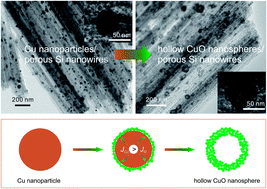Hollow CuO nanospheres uniformly anchored on porous Si nanowires: preparation and their potential use as electrochemical sensors†
Abstract
Hollow CuO nanospheres have been prepared via a reduction reaction of copper ions on porous Si

* Corresponding authors
a
Department of Electrical Engineering, KAIST, 291 Daehak-ro, Yuseong-gu, Daejeon 305-701, Republic of Korea
E-mail:
ykchoi@ee.kaist.ac.kr
b
Research Center for Biomimetic Functional Materials and Sensing Devices, Institute of Intelligent Machines, Chinese Academy of Sciences, Hefei 230031, PR China
E-mail:
xingjiuhuang@iim.ac.cn
Fax: +86-551-5592420
Tel: +86-551-5591167
Hollow CuO nanospheres have been prepared via a reduction reaction of copper ions on porous Si

 Please wait while we load your content...
Something went wrong. Try again?
Please wait while we load your content...
Something went wrong. Try again?
Z. Guo, M. Seol, M. Kim, J. Ahn, Y. Choi, J. Liu and X. Huang, Nanoscale, 2012, 4, 7525 DOI: 10.1039/C2NR32556J
To request permission to reproduce material from this article, please go to the Copyright Clearance Center request page.
If you are an author contributing to an RSC publication, you do not need to request permission provided correct acknowledgement is given.
If you are the author of this article, you do not need to request permission to reproduce figures and diagrams provided correct acknowledgement is given. If you want to reproduce the whole article in a third-party publication (excluding your thesis/dissertation for which permission is not required) please go to the Copyright Clearance Center request page.
Read more about how to correctly acknowledge RSC content.
 Fetching data from CrossRef.
Fetching data from CrossRef.
This may take some time to load.
Loading related content
